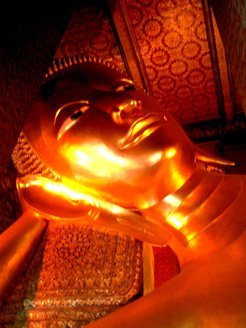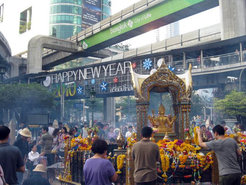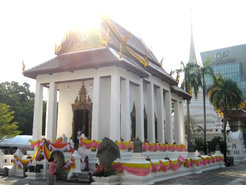Angst and Enlightenment in the City of Angels
by Sophorntavy Vorng

Figure 1: Wat Pho, Rattanakosin.
Thailand abounds with images of the Buddha's half-lidded eyes and mysteriously serene smile, which beckon toward a not so well kept secret: his solution to the universal question of human suffering. This was encapsulated in the Four Noble Truths, namely, that all life is suffering, that the reason for suffering is desire, that the elimination of desire leads to the cessation of suffering, and that this may be achieved by following the Noble Eightfold Path towards Enlightenment. Many millennia later, the message proffered by Siddhartha Gautama so long ago has gained resonance, rather than lost relevance. Contemporary life bears many burdens. Existential suffering has by no means decreased.
Nowhere is this more evident than in Bangkok, which locals refer to as 'Krung Thep', or the 'City of Angels'. Yet, I came to realise that, rather ironically, Bangkok is as mortal a city as one could ever encounter. This is not only because of the oppressive tropical heat, the invasive smells, the incessant clamour, or the seething crowds, all of which are things that an anthropologist raised in quiet and monotonous suburban Sydney also had to learn to deal with. It is more than the pleasures for which Bangkok has come to be known, with its cornucopia of colourful foods, shopper's heaven of markets and malls filling every nook and cranny of the urban landscape, or the ubiquitous massage parlours and red light districts. Rather, its unapologetic worldliness derives in large part from the anxiety-inducing nature of the socio-political order.
Here in Bangkok, a long-running political conflict between elites, which draws legitimacy and popular support from the lower and middle classes, shows only signs of intensification, with more street protests and violence set to come. Decades of rapid economic development, the 1997 financial crisis, and the more recent global recession mean that despite a burgeoning urban middle class, class disparities continue to grow – something which is no doubt fuelling the political turmoil. The wealthy command vast power and privilege, while the remaining majority suffer from a severe lack of opportunity and markedly inferior status. One's merits and abilities count for far less than they should, if at all, because connections reign supreme.
Compounding these things are the increasing difficulties involved in maintaining fulfilling social relationships and a meaningful sense of identity amidst the alienating character of life in such an enormous metropolis, as well as the devil that urban Thai society shares with much of Asia and the remainder of the world, and which cannot be overlooked: consumerism. Connected to this is the strong cultural emphasis on materialistic status display that pervades everyday life in Bangkok, and which defines the intense social competitiveness in which individuals have no choice but to participate if they desire to secure, or improve, their position in the social hierarchy.
Nevertheless, a survey of downtown Bangkok today will show that even amongst the heavy development, there is strong evidence to suggest that religion continues to serve a variety of important functions for cosmopolitan urbanites. These beliefs and practices are notably syncretic, comprising complex combinations of Theravadin, Mahayanist, Hindu, and other religious traditions, with modern lifestyles and outlooks.

Figure 2: Erawan Shrine, Ratchaprasong.
For instance, on the first day of the New Year, hordes of Bangkokians clustered around the Hindu shrines which are scattered around the centrally located Ratchaprasong intersection. Especially popular were Ganesh, Trimurti, and Brahma (the latter also famously known as Erawan Shrine). Braving the eye- and nose-stinging fog of aromatic incense smoke drifting from the pleas of fellow worshippers, the throngs waved garlands of fragrant flowers, handfuls of joss sticks, dripping candles, and bundles of Thai baht as they paid obeisance and asked for their wishes for love and success to be granted. Buddhist temples all over the city were also crowded with those eager to start their year auspiciously. Many busy Bangkokians spent their break on trendy Buddhist meditation retreats in the provinces, striving for tranquillity only to relapse into the hustle and bustle when the holidays were over.

Figure 3: Wat Pathum Wanaram, Pathumwan.
Others seek inner peace much closer to home. One striking example can be observed at Wat Pathum Wanaram, a royal temple flanked by Bangkok's two biggest shopping malls, Siam Paragon and CentralWorld Plaza, which, at 300 000 and 500 000 square metres of retail space, respectively, are bastions of Bangkokian middle class consumerism. Here, office workers, university students, socialites, and white-collar professionals can be found very early in the mornings, sitting quietly in repose in the lotus position before beginning their demanding days. In the exclusive Chit Lom district, not far away, more of the same middle class individuals, some toting flashy designer bags, attend meditation sessions and dhamma talks by famous monks inside looming office towers.
Amidst so much social, political, and economic uncertainty, it is no surprise that in the present day, Bangkokians continue to seek the solace of the Buddha's teachings – albeit in dramatically transformed fashion. This speaks to the importance of considering the wider socio-cultural context when undertaking the study of religion. Delving into the former provides important clues as to why contemporary religious belief and practice takes the forms and patterns that it does, and why. This means keeping one's finger on the pulse of the social milieu, something which can be incredibly difficult in such an enormous, diverse, and dynamic field setting as Bangkok. The problem is not that one cannot collect enough data, but that there is often too much data to process.
Fieldwork in huge metropolises has become more and more commonplace as the discipline evolves with the times and with widespread urbanisation – as evinced by our institute's 'Urban Aspirations in Megacities' project. However, ethnographic research in a city setting differs from research in a traditional setting in a number of ways. Potential research subjects number not in the tens, hundreds, or even thousands, as in a village or tribe, but in the millions. In addition, there is the daunting scale and complexity of the field site itself.
In this case, classic participant-observation alone is insufficient, and it is necessary to draw on a wide range of different sources of data, such as surveys, television and print media, interviews, historical texts, and so on, in order to account for this particular limitation. This can then be added to the understandings gained from participant-observation and in the process of interacting with one's informants, and discussing with them the struggles, hopes, and fears that are related to life in Bangkok. The perspective, or 'enlightenment', as it were, that such an approach to ethnography and analysis offers is that, in Bangkok, what one might refer to variously as the 'sacred', 'spiritual', or 'religious', straddles the elephantine spine of its very profanity.














